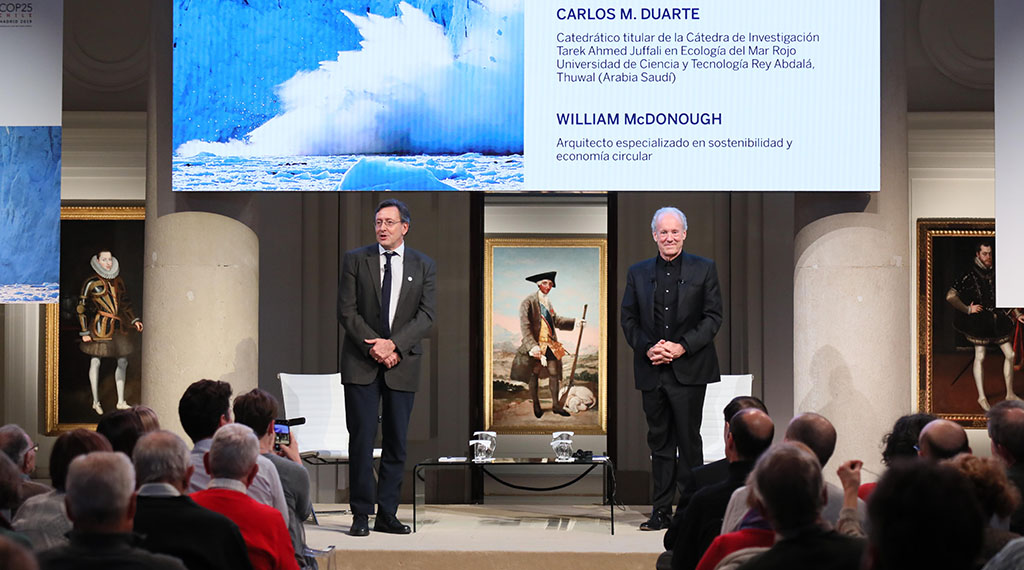The circular economy of carbon as a remedy for climate change: dialogue between Carlos M. Duarte and William McDonough in the frame of COP25
Professor Carlos M. Duarte, a marine ecologist specializing in climate change, and American architect William McDonough, the sustainable design pioneer, participated this past Monday, 9 December, in a dialogue on “The circular economy of carbon.” This was the second event organized by the BBVA Foundation on the occasion of the 25th United Nations Framework Convention on Climate Change Conference of the Parties (COP25) taking place in Madrid. Watch the discussion in full by clicking on the “play” button above.
9 December, 2019
Duarte and McDonough shared the results of their joint research into a new systemic framework that they hope can turn back the threat of global warming. Their proposition draws on lessons learned from the natural carbon cycle: how it operates and the mechanisms that have allowed it to move vast quantities of carbon without disrupting the climate system.
“The natural carbon cycle is the fundamental engine of the biosphere, enabling life to thrive,” explained Duarte. “And this cycle depends for its functioning on the abundance of life, what we might call natural capital.”
The problem is that human activity has perturbed this natural cycle through the emission of greenhouse gases, and it is now imperative that we find a way to restore it to balance. “Carbon – the element – is not the enemy,” McDonough pointed out. “Climate change is the result of breakdowns in the carbon cycle caused by us: it is a design failure.”
“Humanity believed that it could rule over nature,” added Duarte, “but in fact we are its servants, and what we need to do is learn from nature how to solve our problems, instead of destroying it.”
In effect, the excess of CO2 and other greenhouse gases generated by human activity have made airborne carbon a material “in the wrong place, at the wrong dose and for the wrong duration,” as McDonough describes it. So in reality, he continues, “it is we who have made carbon toxic,” like lead in our drinking water. And we should not lose sight of the fact that, in the right place and quantity, “carbon is a resource and a tool,” indispensable for the health of our planet.
CO2, after all, said the U.S. architect, is at the heart of photosynthesis, a source of Earth’s capacity for regeneration, while soil carbon is the guarantor of healthy ecosystems. So carbon atoms are, in short, “the building blocks of life.”
The “new language” of carbon
It is for all these reasons that both Duarte and McDonough, who has devoted thirty years of his professional life to the design of sustainable buildings, contend that the best strategy to combat climate change is not to “declare war” on carbon, but rather to define ways in which this element can be used “safely, productively and profitably.”
“We can take inspiration from nature in capturing the excess CO2 present in our atmosphere,” Duarte insisted. “We should be turning nature into the ‘new capital’ that provides the fundamental ‘interests’ on which humanity depends: clean air and clean water, food, natural resources, climate regulation, cultural values and well-being.”
The goal of this “new language of carbon,” as the two experts discussed in their talk, is to preserve and enhance the benefits that the element naturally provides though a “circular economy” in which both farming and urban design are run along fully sustainable lines.
The idea, says McDonough, is to construct buildings that act like trees and cities that act as forests, in the sense that they become “biologically active” without disrupting the natural carbon cycle, through the use of solar energy, green roofs and urban farms, water recycling and purification systems and other strategies already deployed successfully in pilot schemes that McDonough has promoted in the U.S., Germany and the Netherlands.
“We have to rebuild the ‘natural capital’ that we have lost,” said Duarte, “by embarking on large-scale reforestation programs that will allow both terrestrial and marine ecosystems to recover their ability to capture carbon from the atmosphere.”
The U.S. architect expanded on this point: “We need to build an ‘ecocivilization’ where all designs – from products to buildings, cities and farms – are made ‘carbon positive’. This may take a century, but that’s how long it took us to get into our current carbon calamity. And the sooner we start, the better.”
The key message emerging from this dialogue between scientist and architect is that the challenge we face is immense but not insurmountable. As Duarte recalled, “when Kennedy announced America’s plans to travel to the moon, he said that they would do it not because it was easy, but because it was hard. There is no question that tackling climate change will be a difficult battle, but it is not impossible, and it is one that must be fought.”

